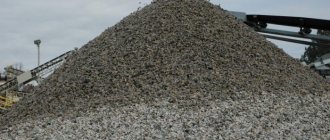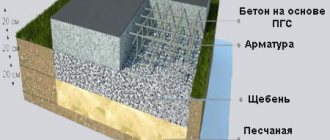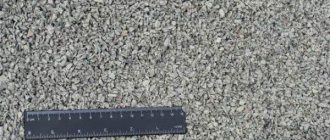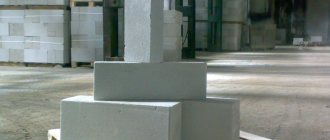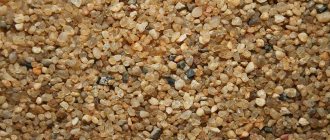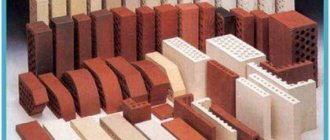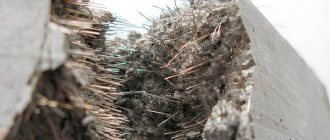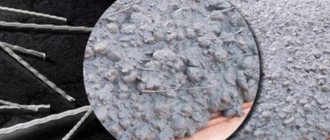Crushed stone is a common building material. Area of use: filler in concrete mixtures and reinforced concrete products, laying the base when constructing foundations, floors, asphalt concrete road surfaces. Large fractions are used for ballast prism during the construction of railway tracks.
Frost resistance of crushed stone plays an important role in the characteristics of the material, since it is regularly exposed to the environment: moisture and low temperatures. This property affects the wear resistance and strength of crushed stone, and therefore the durability of the structure or embankment.
What is frost resistance of crushed stone
Frost resistance is understood as the ability of a rock in a moist state to withstand numerous freezing followed by thawing, without losing weight more than that established by the standard.
What affects the frost resistance of crushed stone? Low temperature resistance parameters are inextricably linked with water absorption. As a result of repeated and alternating exposure to heat and low temperature, a gradual decrease in the strength of the material and destruction occurs. The water that fills the pores of the rock when it freezes increases in volume. The resulting ice crystals, expanding and filling the pore space free of water, exert significant pressure on their walls. Therefore, sufficient frost resistance is ensured provided that the water absorption of the material does not exceed 80% of the pore volume.
Frost resistance of crushed stone
The road surface is influenced by the environment; temperature and humidity are constantly changing. With the onset of cold weather, the coating freezes; during the winter it can settle several times and freeze again. Ice crystals break the bonds between asphalt components. Strength and wear resistance deteriorate, which reduces the strength of the surface layer.
When choosing crushed stone for road construction, it is necessary to take into account its frost resistance - the ability to withstand a certain amount of freezing and subsequent settling without losing a certain percentage of mass. The frost resistance indicator sets the standard; it varies from 1 to 10%. The higher the frost resistance, the less loss.
Frost-resistant crushed stone
How to determine the frost resistance of crushed stone
To determine the frost resistance parameters of crushed stone, GOST 8267-93 provides two test methods:
- sequential freezing and thawing of the test sample;
- saturation of the sample in a solution of sodium sulfate followed by drying (accelerated method).
The first method includes the following sequential steps:
- The sample, dried to a constant weight, is immersed in a metal container with water and kept for 2 days.
- The filler is removed and placed in the freezer, setting the temperature to -20 degrees. Freezing time – 4 hours.
- Then the filler is placed under a stream of warm water (t = +20 - +25 degrees) so that the material is completely thawed. The time required for defrosting is at least 2 hours.
- Repeat the cyclic process of freezing and thawing.
The procedure for testing crushed stone for frost resistance is carried out separately by fraction. For samples of each fraction, standards provide for a minimum mass. For example, a sample of grains measuring 10 - 20 mm should be 1.5 kg, for crushed stone 20 - 40 mm - 2.5 kg.
After completing 15 and 25 cycles, the analytical sample is thoroughly dried and sifted using a special laboratory sieve (control). This procedure is repeated after every 25 cycles. By comparing the initial mass of the sample with that obtained after the test, its actual loss is determined. The indicator is compared with the acceptable one. If it does not exceed the maximum value specified in GOST, then the test procedure is continued. When the result is higher, testing is stopped, assigning a grade to the crushed stone. It will correspond to the indicator of the previous cycle.
Determination of frost resistance of crushed stone by the accelerated method is carried out using a solution of sodium sulfate, which is poured into the sample. After 20 hours, the liquid is drained, the filler is washed and dried in a drying chamber for 4 hours. (t = +110 degrees). Then the cycle is repeated again.
Based on frost resistance, crushed stone is divided into 8 grades, which are designated by the letter F with a digital cycle parameter. Grades F15 and F25 are considered unstable, F50 – F150 are classified as stable, crushed stone frost resistance grades F200, F300 and F400 are characterized as highly resistant.
Frost resistance indicators of crushed stone and gravel according to GOST 8267-93
⇐ PreviousPage 6 of 7Next ⇒| Type of test | Frost resistance grade for crushed stone and gravel | ||||||
| F15 | F25 | F50 | F100 | F150 | F200 | F300 | F400 |
| Freeze-thaw: | |||||||
| number of cycles | |||||||
| weight loss after testing,%, no more | |||||||
| Saturation in sodium sulfate solution - drying: | |||||||
| number of cycles | |||||||
| weight loss after testing,%, no more |
Freezing method . Frost resistance of crushed stone (gravel) is determined by the loss of sample weight during alternate freezing and thawing.
Necessary equipment : freezer, ensuring the achievement and maintenance of temperature down to minus (20±2)°C; drying cabinet; tabletop dial and laboratory scales; sieves from the standard set; bath for saturating water and thawing crushed stone (gravel); metal vessel.
Sample preparation . Each fraction of crushed stone (gravel) is tested separately for frost resistance. Fractions contained in crushed stone (gravel) in an amount of less than 5% by weight are not tested for frost resistance. For testing, two analytical samples are taken from each fraction. The mass of each sample must be at least: 1.0 kg - for crushed stone (gravel) with a fraction size of 5 to 10 mm; 1 5 kg - St. 10 to 20 mm; 2.5 kg - St. 20 to 40 mm; 5.0 kg - St. 40 to 70 (80) mm. Grains larger than 70 (80) mm are crushed and tested for a fraction of size St. 40 to 70 (80) mm.
Carrying out the test . The resulting crushed stone (gravel) samples are washed and dried to a constant weight. An analytical sample of crushed stone (gravel) of this fraction is evenly poured into a metal vessel and filled with water at a temperature of (20±5) °C. After 48 hours, drain the water from the vessel, place the crushed stone (gravel) in the freezer and bring the temperature in the chamber to minus (18±2)°C. The duration of the freezing cycle of crushed stone (gravel) in a chamber at a steady temperature of no higher than minus 16 ° C should be 4 hours. After this, the vessel with crushed stone (gravel) is placed in a bath with running or replaceable water at a temperature of (20 ± 5) ° C and kept in it at this temperature until the crushed stone (gravel) is completely thawed, but not less than 2 hours. Then the test cycles are repeated.
After 15, 25 and every subsequent 25 cycles of alternating freezing and thawing, a sample of crushed stone (gravel) is dried to a constant weight, sifted through a control sieve, on which it completely remained before testing.
The weight loss of the sample is calculated using the formula
, (22)
where is the mass of the sample before testing, g; - mass of residue on the sieve after the corresponding test cycle, g.
Accelerated determination of frost resistance . Frost resistance of crushed stone (gravel) is determined by the weight loss of the sample when immersed in a saturated solution of sodium sulfate and subsequent drying.
Necessary equipment : tabletop dial or laboratory scales; drying cabinet; sieves from the standard set; metal vessel; sodium sulfate according to GOST 4166, GOST 4171.
Sample preparation . Each fraction of crushed stone (gravel) is tested separately. The analytical sample is prepared according to the method described above.
A solution of sodium sulfate is prepared as follows. Weigh 185 g of anhydrous sodium sulfate or 420 g of crystalline sodium sulfate and dissolve in 1 liter of distilled water heated to 40 ° C by gradually adding sodium sulfate to it with thorough stirring until the solution is saturated, cool the solution to room temperature, pour into a bottle and leave for 2 days.
Carrying out the test . An analytical sample of crushed stone (gravel) is poured into a vessel in one layer, filled with a solution of sodium sulfate so that the crushed stone (gravel) is completely immersed in the solution, and kept in it for 20 hours at room temperature.
Then the solution is drained (reused), and the vessel with crushed stone (gravel) is placed for 4 hours in a drying cabinet, in which the temperature is maintained at (105 ± 5) ° C. After this, the crushed stone (gravel) is cooled to room temperature and again filled with solution.
Subsequent test cycles include keeping crushed stone (gravel) for 4 hours in a solution of sodium sulfate, drying for 4 hours and cooling to room temperature.
After 3, 5, 10 and 15 cycles, a sample of crushed stone (gravel) is washed with hot water to remove sodium sulfate, dried to a constant weight and sifted through a sieve with holes of .
The residue on the sieve is weighed and the loss in sample weight is determined and calculated using formula (19).
The arithmetic mean of two parallel tests is taken as the test result.
When testing crushed stone (gravel) consisting of a mixture of fractions, each fraction is tested separately and the value is determined as the weighted average value of the determined indicator in accordance with the content of the fraction in the mixture.
If the weight loss for a given number of freezing and thawing cycles does not exceed the permissible value (Table 10), the tests are continued for the next 25 cycles.
If the loss in mass exceeds the permissible limit, the test is stopped and the frost resistance of a given fraction of crushed stone (gravel) is characterized by the previous number of freezing and thawing cycles, during which the mass loss of crushed stone (gravel) does not exceed the permissible limit.
Grains of crushed stone (gravel) of the St. fraction. 40 to 70 mm, having a fresh split surface and remaining on a sieve with holes with a diameter of 40 mm, are classified as non-frost-resistant. Their mass is not included in the mass of the residue on the control sieve.
2.11. Determination of the compressive strength of crushed stone (gravel)
The strength of crushed stone (gravel) is assessed by the compressive strength of the original rock from which it is obtained in a water-saturated state. The strength of rock is determined by compressing and bringing samples (cubes or cylinders) to destruction on a hydraulic press with a force of 100 to 500 kN.
Necessary equipment : hydraulic press with a force from 100 to 500 kN; drilling machine with a diamond ring drill for reinforced concrete structures (for the manufacture of cylinders); stone-cutting machine with a diamond cutting wheel (for making cubes); calipers; calibration square; vessel for saturating samples with water.
Sample preparation . Five samples are made from a rock sample in the form of cubes with an edge size of 40...50 mm or cylinders with a diameter and height of 40...50 mm.
Before determining the strength, the samples are measured with a caliper and dried to constant weight. It is allowed to test rock samples in a water-saturated state.
Testing . The sample is placed in the center of the press base plate. The load on the sample during testing should increase continuously and uniformly at a rate of 0.5 MPa (5 kgf/cm2) per second.
The compressive strength of a sample of the original rock (MPa) is calculated using the formula
, (23)
where is the destructive force at the moment of sample destruction, N; — sample area, cm2.
To control the quality of crushed stone (gravel), the compressive strength of the original rock can be determined by testing the crushed stone for splitting with a mechanical stone strength indicator T-3 (Fig. 5).
The indicator is a portable device with which you can test crushed stone (gravel) grains that have a wedge shape with an angle from 15° to 60°. The minimum size of crushed stone grains suitable for testing is 10 mm.
Sample preparation : The number of grains to obtain reliable results for determining the strength of crushed stone should be: for a homogeneous stone - 5...6 pieces, and in case of significant scattering of results - 10...12 pieces.
A sample of crushed stone is placed between the lower and upper teeth of the device with a wedge-shaped end into the slot stop. By rotating the indicator disk, its screw mechanism lifts the lower tooth, which presses on the upper tooth through the test sample. The latter raises the slider, which presses on the medose diaphragm and thereby creates pressure on the liquid, indicated by the pressure gauge. The pressure gauge scale is calibrated in kg/cm2 of the stone's compressive strength.
To calculate the compressive strength of the original rock, it is necessary to multiply the pressure gauge reading at the moment of sample destruction by a coefficient. To move from the instrument readings to the compressive strength, a transition coefficient is first established based on testing of crushed stone grains with a T-3 mechanical indicator and the strength of rock samples of the correct shape is determined by compression on a press. For limestone stone this coefficient is 10.
⇐ Previous6Next ⇒
WHAT IS CONFIDENT BEHAVIOR IN INTERPERSONAL RELATIONSHIPS? Historically, there are three main patterns of differences that exist between...
WHAT HAPPENS WHEN WE FIGHT Without understanding the differences that exist between men and women, it is very easy to lead to a quarrel...
What Causes Trends in Stock and Commodity Markets Freight Train Theory Explained My first 17 years of market research consisted of trying to figure out when...
What to do if there is no reciprocity? And now let's come down from heaven to earth. Have you landed? Let's continue the conversation...
Didn't find what you were looking for? Use Google search on the site:
Types of crushed stone and frost resistance values
The material obtained from granite is one of the most durable grades of crushed stone in terms of frost resistance (F300, F400). As for crushed gravel, it is inferior to granite in all respects, including frost resistance, which corresponds to F150, F200, and less often reaches F300.
The frost resistance of crushed slag varies and depends on the chemical composition and structure. The porous version of the slag has a low grade of F15, and the product obtained from copper smelting waste is characterized by an index of F300.
The frost resistance parameter of crushed limestone is low - F100.
Frost resistance of crushed stone for road work
The most unfavorable conditions for stone material are road pavement and embankments. Crushed stone is used as an independent layer and as a component in asphalt and cement concrete mixtures.
During the autumn rainy period, there is an excess of moisture, which penetrates the body of the coating and saturates it with moisture. The winter-spring season is characterized by frosts and thaws, alternating freezing and thawing of crushed stone. Therefore, highly resistant material of grade no lower than F300 is used in road construction.
Crushed stone classes and frost resistance value
Based on frost resistance, the material is divided into 8 grades, which are designated by the letter F with a digital cycle indicator. The unstable category includes F15 and F25, therefore they are used to create embankments and unloaded structures, F50–150 are stable, and F200, 300 and 400 are highly stable.
During autumn rainy periods, there is an excess of moisture, which, penetrating into the coating, saturates the crushed stone with moisture. The winter and spring seasons are characterized by frost and thaw periods with variable freezes and thaws. Therefore, in the field of road construction, crushed stone of a grade no lower than F300 is used.
